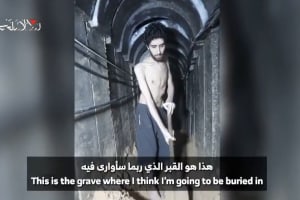Unearthing Shiloh: Inside the ongoing search for the biblical Tabernacle

The site of ancient Shiloh has been excavated for over a century, and as the digs continue, the questions surrounding it only seem to multiply.
At the beginning of excavations, a hundred years ago, researchers expected to locate the site of the Tabernacle quickly – just as Bronze Age cultic sites were found at many other tels known to us. Yet the mystery of the Tabernacle’s precise location in Shiloh remains unsolved.
The challenges of identifying biblical sites
This difficulty stems from several factors, worth explaining since they affect many archaeological sites in Israel.
First is the challenge of reconciling the biblical narrative with the archaeological evidence in the field. Many researchers come to a biblical site hoping to find and confirm what is written in Scripture. But they do not always consider that their interpretation of the biblical text may not be the only way to understand it. They might arrive with a built-in bias about how to interpret the Bible.
It's important to note that the problem of digging with preconceptions is just as present among scholars who reject the Bible's historical reliability. Such researchers sometimes aim to refute it at all costs, bringing their own biases with them. Others develop a particular interpretive model for the finds and try to prove themselves right with every excavation they conduct.
The second difficulty lies in scholarly debates about the dating of biblical events, most notably, the time of the exodus and the entry of the Israelites into Canaan. Opinions differ by as much as 200 years or more – a significant gap that completely changes the historical picture. We will discuss this further below.
The third challenge is the difficulty of dating artifacts using radiocarbon (C-14) or other methods. A potential error of up to 100 years makes the precise dating of layers in many excavated biblical sites a matter of debate. This dating interpretation heavily influences the attribution of a site to a specific biblical narrative.
The fourth and perhaps most significant challenge is that archaeology can never provide a complete picture of what happened at a site. Excavation offers only static snapshots of certain moments, often from a time of the site’s destruction, while much about the people who lived there remains hidden from the archaeologist.
Nonetheless, archaeological methods have advanced greatly over the years and can shed much light on the finds. But in the end, every archaeologist imposes their own interpretive framework and worldview onto the evidence.
Such critique is usually aimed at scholars who believe in the Bible’s historicity, accusing them of “forcing” the evidence to match their expectations. Yet the same problem exists among scholars with different theoretical frameworks, especially those who reject the Bible's truth and try at all costs to prove their own model.
Early efforts to identify the Tabernacle’s location in Shiloh
Returning to Tel Shiloh itself: how have researchers tried to locate the Tabernacle there?
The first to propose an identification was Charles W. Wilson, who suggested in 1873 that the Tabernacle stood on the broad flat area north of the tel. His reasoning was that this area was large enough to accommodate the Tabernacle. Wilson's proposal remains influential, with the Shiloh site offering a probable Tabernacle location based on his ideas.
Wilson's theory found further support in 1 Samuel 4, the account of the messenger running to Shiloh, to tell Eli the high priest, about Israel’s defeat at Ebenezer and the loss of the Ark:
That same day a Benjamite ran from the battle line and went to Shiloh with his clothes torn and dust on his head. When he arrived, there was Eli sitting on his chair by the side of the road, watching, because his heart feared for the ark of God. When the man entered the town and told what had happened, the whole town sent up a cry. Eli heard the outcry and asked, “What is the meaning of this uproar?” The man hurried over to Eli (1 Samuel 4:12-14).
Scholars suggest, based on that story, that the messenger first entered the city through the gate which is found in the southern wall, and after telling the news in the city, proceeded north to the Tabernacle to report to Eli. Reading the story in the geographical context leads to the conclusion that the tabernacle stood outside the city to the north.
However, with both biblical and structural support, no archaeological evidence has yet been found to confirm Wilson’s hypothesis of the tabernacle’s location on the northern plateau.
Byzantine tradition and the southern platform
Another theory places the Tabernacle on the plateau south of the tel. This suggestion is based on the remains of five Byzantine churches in the southern part of the site. The Byzantines likely built these churches to commemorate their belief that the Tabernacle once stood there.
The problem with using the Byzantine tradition is that the Byzantines had fewer resources than we do to confirm archaeological sites with certainty, and over a thousand years separate their tradition from the Tabernacle's time in Shiloh.
Israel Finkelstein’s discoveries
The first archaeologist to find evidence of sacrificial activity at Tel Shiloh was Israel Finkelstein, who excavated there between 1981 and 1984 with Bar Ilan University.
At the top of the tel, on its eastern side within the city walls, Finkelstein found a favissa (a pit for ritual refuse) containing many broken pottery shards, dumped earth, ash, and animal bones dated to the Late Bronze Age (15th–13th centuries B.C.). He interpreted this as waste from a permanent cultic practice at the top of the tel.
Finkelstein suggested that Tel Shiloh served as a major cultic center for the Canaanite population before Israel’s arrival. When the Israelites under Joshua conquered the land, they did not go straight to Shiloh but initially settled in northern parts of Manasseh’s territory. Only later, during Iron Age I, did they reach the tel and establish the Tabernacle at the summit where the previous Canaanite temple had stood.
He also found evidence of a city-wide fire in the mid-11th century B.C., which he attributed to the Philistines' destruction of Shiloh following their capture of the Ark at Ebenezer.
Finkelstein is one of Israel’s best-known and most respected archaeologists. His approach is “minimalist,” meaning he does not treat the biblical text as inherently reliable history, but excavates without presuming its truth and lets the artifacts “speak for themselves.”
As noted earlier, however, there is really no truly “neutral” position. Every archaeologist has assumptions that shape their conclusions.
Scott Stripling’s excavations and interpretation
The current excavator at the site is Scott Stripling of the Associates for Biblical Research. He has been digging at Shiloh for ten years.
While building on Finkelstein's work, Stripling's own findings resulted in significantly different interpretations. Like Finkelstein, he believes the Tabernacle was within the city walls and not in an open platform outside the city, because he believed it needed to be in a fortified area. He also accepts the favissa of ash and bones as evidence of sacrificial practices.
However, Stripling contends that this sacrificial system was Israelite, not Canaanite, and that its use began after the Israelites entered Canaan. In contrast to Finkelstein's view, he believes the Israelites were present in Canaan during the Late Bronze Age.
The dating debate: When did Israel enter Canaan?
This is where the core conflict between Stripling's and Finkelstein's viewpoints emerges.
1 Kings 6:1 reads, "In the four hundred and eightieth year after the Israelites came out of Egypt, in the fourth year of Solomon’s reign over Israel, in the month of Ziv, the second month, he began to build the temple of the Lord."
According to scripture, Solomon began building the Temple 480 years after the Exodus, implying 440 years after Joshua’s conquest. If Solomon reigned in the 10th century B.C.E. (as most scholars agree), then the conquest would have been in the 14th century B.C., in the Late Bronze Age.
By this calculation, the sacrificial installations Finkelstein attributed to the Canaanites would actually belong to the Israelites.
But why do Finkelstein and many other scholars argue the Israelites entered Canaan 200 years later than the biblical text suggests?
Their argument rests on archaeological evidence from Israel’s central hill country. Canaanite cities in the region experienced a sharp decline during the Late Bronze Age (15th-13th centuries B.C.). Many new settlements appeared suddenly in the 12th century B.C.
These scholars interpret the sudden proliferation of settlements in the 12th century as evidence that Israel only emerged in Canaan then.
Stripling and other “maximalists” counter that absence of evidence is not evidence of absence. The absence of earlier remnants, they contend, doesn't rule out prior inhabitants; perhaps dwellings were temporary, like tents, instead of stone structures. For maximalists, the biblical testimony remains crucial and they cannot simply dismiss it.
It’s important to note that not all evangelical scholars agree with Stripling’s maximalist dating. Many evangelicals hold a more minimalist view, dating Israel’s conquest to the later 12th century B.C. Such scholars do not reject biblical authority, but suggest that the number “480 years” in 1 Kings 6:1 is symbolic (12 x 40) rather than a literal historical figure.
Stripling’s possible discovery of the Tabernacle site
Returning to Stripling: he believes he may have found the actual location of the Tabernacle.
Just west of the favissa of broken pottery, bones, and ash, slightly north of the tel’s summit, he uncovered a large public building with east-west walls and dimensions matching those of the Tent of Meeting described in Exodus 26. Inside, he found artifacts that might be evidence of priestly worship. He believes he's found what archaeologists have spent years searching for: the tabernacle of Shiloh.
Stripling has not yet published his final conclusions. We'll just have to wait and see what other surprises Tel Shiloh holds for us.

Ran Silberman is a certified tour guide in Israel, with a background of many years in the Israeli Hi-Tech industry. He loves to guide visitors who believe in the God of Israel and want to follow His footsteps in the Land of the Bible. Ran also loves to teach about Israeli nature that is spoken of in the Bible.
You might also like to read this:



![Temple Mount Sifting Project archaeologist Mordechai Ehrlich holds a First Temple period clay sealing reading “Yed[a‛]yah (son of) Asayahu” found in July 2025. (Photo: Temple Mount Sifting Project)](https://res.cloudinary.com/hb0stl6qx/image/upload/w_300,c_scale,q_auto,f_auto,dpr_auto/v1754066993/AIN/MORDECHAI-EHRLICH-1024x640.jpg)












